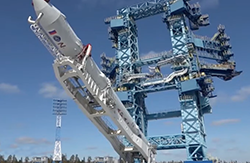Angara 1.2 Rocket Makes First Operational Launch Written 3 May 2022
In This Section

Angara 1.2 rocket being raised to vertical position. | Credit: Space Traveller; YouTube; framegrab
Aviation Week reports that the Russian Aerospace Forces “conducted the first operational launch of a light Angara 1.2 rocket from Plesetsk spaceport in the northern part of the country on April 29. According to the Russian Defense Ministry, the launch vehicle successfully orbited the Cosmos-2555 military satellite.”
Full Story (Aviation Week)
Video
Russian Angara 1.2 carrier rocket Moved to LaunchPad
